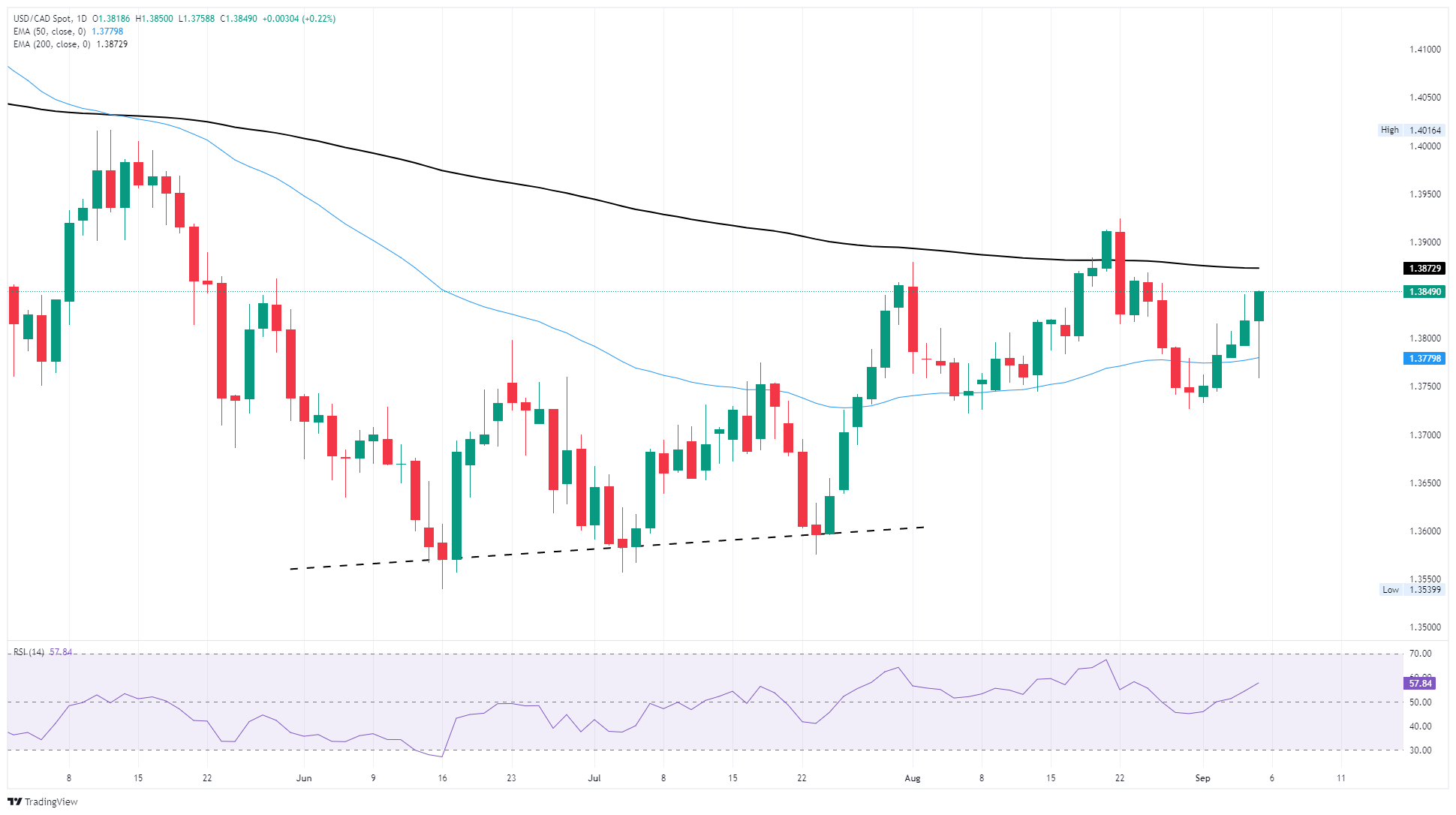Canadian Dollar reverse bullish momentum, backslides further on Friday
- The Canadian Dollar tumbled 0.65% against the US Dollar on Friday.
- Worse-than-expected NFP jobs data sent investors piling into the Greenback safe haven.
- Canadian jobs data did no favors for the Loonie, showing a sharp contraction in the labor market.
The Canadian Dollar (CAD) soured on Friday, skidding into a fifth consecutive losing day against the US Dollar (USD) after employment figures from both Canada and the United States (US) showed both countries are failing to absorb the negative impacts of US President Donald Trump’s trade war with the rest of the world.
Employment data for both Canada and the US soured on Friday as President Trump’s global tariffs weigh on both the US economy and the labor market of the US’s closest trading partner, Canada. US Nonfarm Payrolls )NFP) came in well below expectations, while Canadian hiring figures showed a steep contraction in August, sparking both fresh recession fears and a sharp uptick in central bank rate cut bets on both sides of the 49th parallel.
Daily digest market movers: Souring jobs data pummels Canadian Dollar
- Canada saw a net contraction of 65.5K jobs in August, well below the expected recovery to 7.5K.
- The US also saw NFP jobs gains of just 22K, well below the forecast of 75K.
- The Canadian Dollar reversed early gains on Friday, tumbled two-thirds of one percent top-to-bottom and pushing the Loonie into a fifth straight day of losses against the US Dollar.
- USD/CAD has been pushed back above 1.3840 as risk-off flows bolster the US Dollar across the board.
- Canada is functionally absent from the economic calendar next week, leaving key US inflation data in the driver’s seat.
Canadian Dollar price forecast
The Canadian Dollar’s sharp reversal on Friday, driven by darkening labor market skies, has sewered odds of a Loonie resurgence. USD/CAD is back into the 1.3850 region, and has chalked in a fresh technical bounce from the 50-day Exponential Moving Average (EMA) near 1.3780.
Bullish Greenback flows are pushing USD/CAD back into reach of the 200-day EMA near 1.3870, and current momentum is poised to see a fresh challenge of the last swing high into 1.3925.
USD/CAD daily chart

Canadian Dollar FAQs
The key factors driving the Canadian Dollar (CAD) are the level of interest rates set by the Bank of Canada (BoC), the price of Oil, Canada’s largest export, the health of its economy, inflation and the Trade Balance, which is the difference between the value of Canada’s exports versus its imports. Other factors include market sentiment – whether investors are taking on more risky assets (risk-on) or seeking safe-havens (risk-off) – with risk-on being CAD-positive. As its largest trading partner, the health of the US economy is also a key factor influencing the Canadian Dollar.
The Bank of Canada (BoC) has a significant influence on the Canadian Dollar by setting the level of interest rates that banks can lend to one another. This influences the level of interest rates for everyone. The main goal of the BoC is to maintain inflation at 1-3% by adjusting interest rates up or down. Relatively higher interest rates tend to be positive for the CAD. The Bank of Canada can also use quantitative easing and tightening to influence credit conditions, with the former CAD-negative and the latter CAD-positive.
The price of Oil is a key factor impacting the value of the Canadian Dollar. Petroleum is Canada’s biggest export, so Oil price tends to have an immediate impact on the CAD value. Generally, if Oil price rises CAD also goes up, as aggregate demand for the currency increases. The opposite is the case if the price of Oil falls. Higher Oil prices also tend to result in a greater likelihood of a positive Trade Balance, which is also supportive of the CAD.
While inflation had always traditionally been thought of as a negative factor for a currency since it lowers the value of money, the opposite has actually been the case in modern times with the relaxation of cross-border capital controls. Higher inflation tends to lead central banks to put up interest rates which attracts more capital inflows from global investors seeking a lucrative place to keep their money. This increases demand for the local currency, which in Canada’s case is the Canadian Dollar.
Macroeconomic data releases gauge the health of the economy and can have an impact on the Canadian Dollar. Indicators such as GDP, Manufacturing and Services PMIs, employment, and consumer sentiment surveys can all influence the direction of the CAD. A strong economy is good for the Canadian Dollar. Not only does it attract more foreign investment but it may encourage the Bank of Canada to put up interest rates, leading to a stronger currency. If economic data is weak, however, the CAD is likely to fall.

